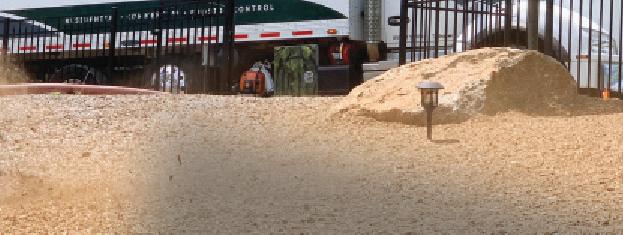






































































Pollinators Play A Crucial
As the Only Pollinators, and they Are Perhaps the Most Important Single Element In This Important Process. But Butterflies, Bats, Birds, Wasps and Beetles Also Play A Role. Unfortunately, Some Are Under Generational Stress While Others Are Actually In Decline. Together, We Can Make A Difference In Saving them.
The USDA Reports That More Than 100 Crops Rely On Pollinators, With An Annual Economic Impact In the Tens of Billions. Issues Even With One Key Pollinator Can Have Catastrophic Results. For Instance, the Western Honey Bee Has Been Struck By Colony Collapse Disorder. Worker Bees Are Disappearing, Leaving Only the Queen and A Few Others. The Cause Is Likely Environmental Stressors, According To the USDA, Including Pollutants, Pests, Disease and Nutritional Deficits. Growers, Conservationists and Government officials Leaped Into

Action, and the Bee Population Began To Rebound. Still, there Are Many Others Who Remain At Risk.
One of the Easiest Ways To Support Pollinators Is At Your Local Grocer, Farmer’s Market or Shopping Center. Look For Products That Have Been Certified Through the Bee Better Program Funded Through the USDA’s Natural Resources Conservation Service. Growers and Manufacturers Earn This Certification By Using Pollinatorfriendly Practices. Buying Things With the Bee Better Logo Helps Sup-
port Those Who In Turn Support Pollinators.
Try Creating Landscapes and Gardens That Feature Native Species, Timing them To Flower During Different Seasons In order To Provide A Steady Source of Food For Pollinators. Clump Flowers With Different Shapes and Colors To Attract them. Those Who Live In Areas Where Monarch Butterflies Migrate Can Plant Milkweed, Which Provides Food For Caterpillars.
Gardeners Can Also Provide Nesting Sites To
Encourage these Populations To Grow. Many Prefer Specific Plants For their Young: For Hummingbirds, It’s Shrubs and Trees. Monarchs, On the Other Hand, Like Milkweed. Bees Prefer To Build Nests In Wood, In the Ground or In Dry Plant Stems. If You Decide To Encourage Bees By Building A Ground-nesting Site, Make Sure It’s Facing South So the Bees Get the Most Sun and That It Is Well-drained. Hollow Stumps Make A Great Habitat; there Are Also Artificial Nesting Sites Available At Retail Outlets That Add A Nice Touch To Any Garden.



Ready To Let Somebody Else
Landscaping Professionals Can Relieve the Stress and Strain of Maintaining Your Lawn, Shrubs and Flower Beds. They May Even Have Some Exciting New Ideas That Transform the Space. Hiring Local Professionals Also Routes Money Back Into Your Hometown Economy. But there Are Key Considerations Before Hiring A Landscaper That Include Everything From Qualifications To Price. Negotiating May Be Crucial To Getting the Best Deal, Since In Some Cases there May Be Different Pricing Structures Based On How often they’ll Have To Come Out During off Seasons.
Landscaping Companies Come In All Sizes, From Local Neighborhood Companies To Nationwide Behemoths. Hometown Independent Contractors Will Typically offer More Straight-forward Service Options Like Mowing, Spreading Mulch, Planting and Perhaps Even Sprinkler Installation and Maintenance. Larger Outfits
May offer A More Comprehensive Package That Includes Whole-space Transformations and Robust Teams To More Quickly Complete Each Visit. In Many Cases, the Choice That’s Right For You Will Come Down To What You Need – and What You’re Willing To Pay.
Once You’ve Evaluated Your Personal Needs, Narrow Your Search To Those Who Provide these Services At A Price You’re Willing To Pay. Next, Check Out Online Reviews and their Ratings At Independent Websites Like NextDoor, Yelp and Google. Check References and Ask Around. If Neighbors Are Using A Lawn Service, they May Be Able To Provide Critical Tips On Who To Hire.
Pricing For Regular Upkeep Might Be Similar With Several Different Companies, While Larger Landscape Installation Jobs Are More Widely Varied. Landscape Curbing Will Up the Price Tag On Sod Installation, For Instance.
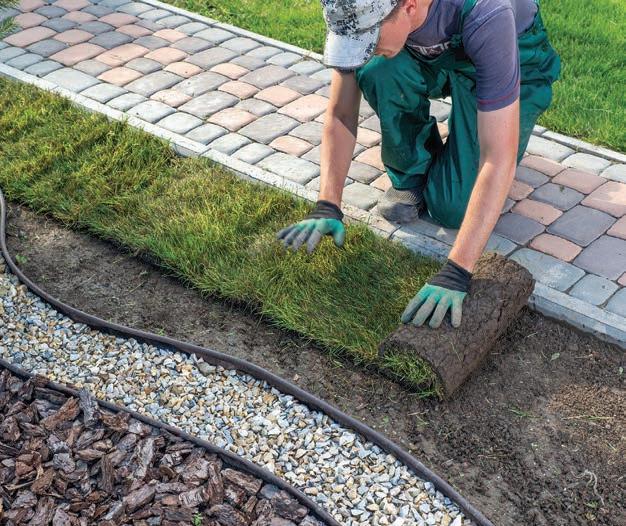
Mowing Will Be Cheaper Than Regrading or Hydroseeding. In-ground Features and Architecture Associated With Things Like Outdoor Grills Can Run Into the Thousands of Dollars. You May Be Able To Find Seasonable Discounts Either Online or In Local Publications.
NEGOTIATING A DEAL Prospective Landscapers Should Provide A Pricing Sheet That Details Costs For Each Service, Along
With Schedules and Payment Options. Inquire About Discounts Associated With Bundling. For Instance, Installation of A Stone Pathway Might Be offered At A Cheaper Price If Service Pros Are Already On Site Doing Other General Landscaping Jobs. Find Out If Your Pricing Changes When Plants Go Into Hibernation For the Winter. And Don’t Forget To Ask If there Are Any Other Deals You’re Unaware of.





Because of Daylight Savings Time, and A Long Tradition of Tackling the Dirt, Clutter and Grime That’s Built Up Over the Winter. In Some Cases, You May Feel Overwhelmed By It All. Or You Just Might Want To Give A Home the Kind of Scrub Down That Your Busy Schedule Doesn’t Allow. In Any Case, A Homecleaning Service Can Have Your Spaces Looking Sparkling and New, Just In Time To Switch Out Boots and Mittens For Flip-flops and Shorts.
Nearly 80% of U.S. Households Participate In Some Sort of Spring Cleaning Every Year, According To One Study From the American Cleaning Institute. The Process Typically Takes Around Six Days From Start To Finish. However, Almost 35% of Respondents Didn’t Believe they Clean often Enough. More Than 40% Honestly Couldn’t Remember the Last Time they Cleaned their Refrigerator.
Nearly Half Said their Dirty Windows Were the Biggest Priority As Winter Gave Way To Warmer Months. The Next Places Listed Included Closets and Drawers, then Ceiling Fans, Curtains and Blinds, Carpets and Flooring, Linens and Home-office Space. That’s A Daunting List For Anyone To Handle, In Particular When Pressed For Time With Work and Family Obligations.
Evaluating Potential Housecleaning Service
Pros Is A Multilayered Process. You Should Have A
Conversation With A Company Representative, But Also Should Speak Directly To the Person Who Will Be Visiting Your Home. You Want To Be Comfortable With the Price and the Services Rendered, But You’ll Also Be Allowing Someone Into Your Private Space. So It’s Important That there Is A Comfort Level Before Deciding On Any New Hire. This Is Especially So If You’re Going To Be Gone When the Cleaning Is Underway.
Create A Budgeted
Amount That You Can Comfortably Set Aside For This Expense Before Getting Estimates. Companies Should Schedule An Inhome Visit In order To Visually Confirm the Size of the Job. Final Cost Estimates Can Vary, Depending On the Number of Rooms and Frequency of Cleaning Visits. Credentials, Insurance, References and A Background Check Are All Recommended Parts of the Vetting Process. Look For Online Reviews On Independent Sites, and Ask Friends, Family and Coworkers For Recommendations.


Build-up Throughout the Winter Can Leave Our Windows, Doors and Home Exteriors Covered In Unsightly Muck.
Power Washing Can Leave It All Looking As Good As New. But Don’t Stop there: This Powerful Tool Is Also Great At Bringing A Host of Other Things To Life In Your Home and Garden, Including Dri veways, Grills, Outdoor Furniture, Decks, Fences and Walkways. Just Keep Important Safety Guidelines In Mind:
Power Washers May Be Powered By Electricity or Gas. Gas-powered Units Are Usually More Powerful Than the Electric Versions. They Typically Deliver Up To 3,000 Pounds of Pressure Per Square Inch, Which May Be Too Much For Certain Materials. That’s Why It’s Important To Match the Power of Your Equipment With the Job: Vinyl Siding Can Withstand That Level of Pressure, But Aluminum, Soft-grain Woods and Stucco Are Only Rated To 1,500 PSI.
Cover Items Like Air Conditioner Compressors and Light Fixtures Around the

Home’s Exterior. Protect Nearby Plants, Too. Note the Location of Outlets and Windows, Covering Sockets With Tape and then Avoiding Those Areas. Put On Safety Gear Before Engaging the Power Washer, Including Work Gloves and Safety Goggles. Pre-wash the Exterior With A Brush or Spray In order To Remove Loose Debris, Dirt and Mildew. Keep the Wand At Least Six Feet Away From Electric Wiring, and Stay Away From Cracks and Holes In the Exterior.
GETTING UNDERWAY
Mix Water and Detergent, Following Manufacturer Directions, then Attach the Power Washer To A Garden Hose. Next, Attach the Preferred Wand or Extension To the Sprayer. Test the Power Washer From A Distance of Three Feet Back, Making Slight Adjustments Until You Can Clean Without Creating Surface Damage. Once You’ve Completed the Job, Turn off the Washer and Disconnect It From Your Garden Hose. Rinse off Any Excess Soap
Before Storing.
RENTING OR BUYING?
Power Washing Equipment Can Be Rented Through Many Home Improvement and Hardware Stores. That’s A Smart Choice When Doing Annual Cleaning of A Home Exterior, Deck or Driveway, Since You’re Saving the Cost of Buying An Expensive Piece of Equipment That You Won’t Otherwise Use. It May Make Sense To Purchase If You Have More Regular Jobs.

As you’ve been admiring all the fresh green growth in your landscape this spring, perhaps you’ve noticed something else, too. Like excessive growth of a tree or shrub that you want to cut or trim back.
There are important things to consider when pruning in the spring. Such as, proper timing, the amount to be pruned and the tree species that are best suited for this time of year. The ultimate goal with spring pruning should be to accomplish two things:
1. Pruning for safety: Identifying and removing any dead, dying or decaying branches to maintain a safer space for your landscape and home.
2. Minimal pruning for aesthetics: Enhance the beauty of your landscape by addressing winter damage, promoting new growth, and shaping trees and shrubs for a picturesque appearance.
Timing: Optimal pruning time is early in the spring, prior to bud-break and new growth begins.
Minimal Approach: Pruning only what is necessary to maintain natural and healthy growth throughout the growing season.
Tree Species: Different trees have unique needs. Some trees do better than others with spring pruning, some of those include but are not limited to:
o Crabapple
o Lilac
o Dogwood
o Magnolia
Health Assessment: Beyond aesthetics, we assess the overall health of your trees. Addressing concerns early and providing proactive care can help keep your trees healthy.
We understand the delicate balance between maintaining aesthetics and ensuring safety when it comes to

pruning your trees. Our expert guidance ensures your trees will flourish all year long.
If you have any questions about which trees are best to prune at this time of year, contact your local arborist for recommendations. Your local ISA Cer-
ti
fied Arborist® at The Davey Tree Expert Company can provide you with a complimentary consultation to ensure you can enjoy a beautiful and flourishing landscape this year.
Trust our seasoned arborists to bring out the best in your landscape this spring. Contact your local tree care experts at 302-644-5912 for a plant health care consultation today!
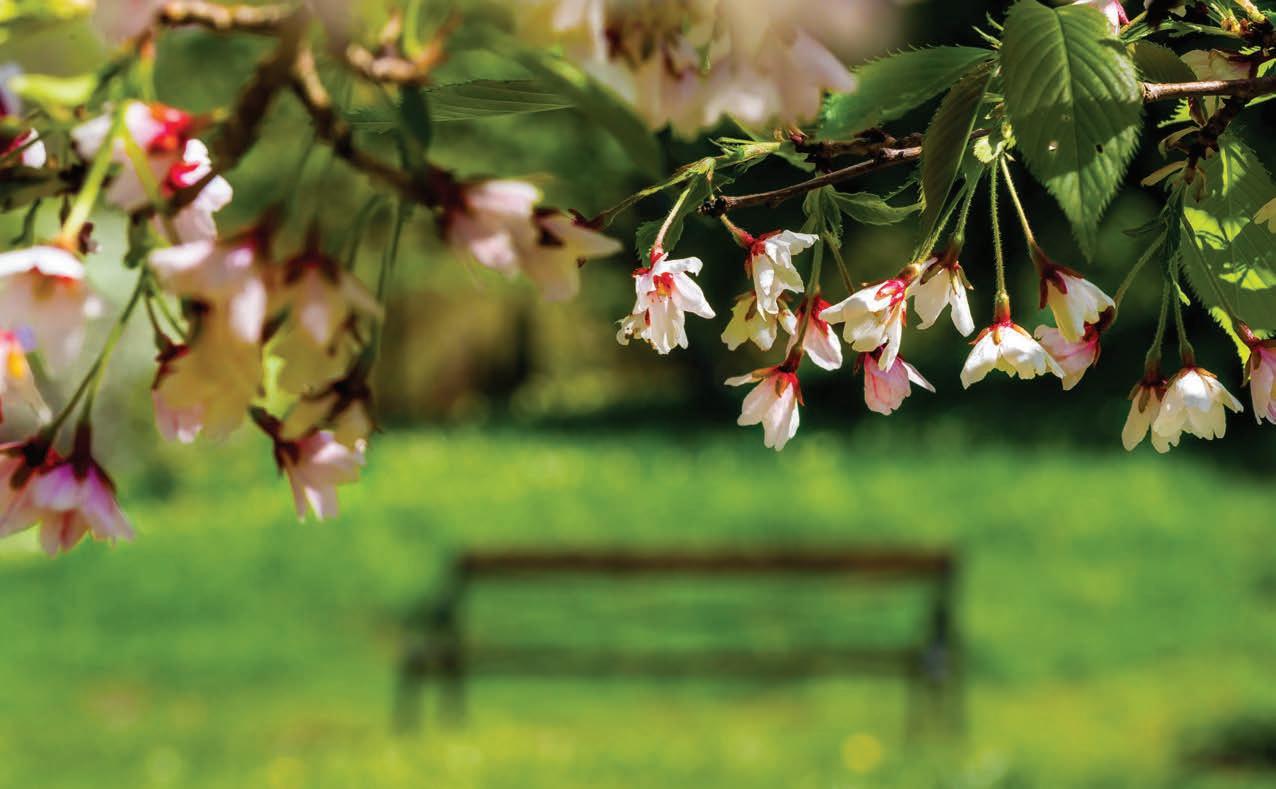

These Zones Detail the Minimum Temperatures For Growing Plants By Area. Find the Zone For Your Area, then Stick To Plants That Are Best Suited For Those Temps. Your Lawn or Garden Will Rebound In No Time.
This Document Is officially Known As the USDA Plant Hardiness Zone Map, and It’s Meant To Set the Standard For Gardeners To Determine Which Plants Thrive By Location. There Are 11 Growing Zones In the U.S., With Eight Located In the Lower 48 States. Temperature Minimums Begin All the Way Down To -60 To -55 Degrees, In Zone 1a. The Far Warmer Zone 13b, On the Other Hand, Is At the Other End of the Spectrum With Temps In the 65-to-70-degree Range. These Numbers Represent the Average Coldest Temperatures Each Year, and Not the All-time Lowest. Be Prepared For Early Spring Freezes, Where Appropriate.
Your Growing Zone Can Be Found By Using the USDA’s Helpful Interactive Map At Planthardiness.ars.usda.gov. Simply Enter Your ZIP Code To Learn More. Static Images
Are Also Available For Those Without Faster Broadband Internet Access. You Can Also Get More Details About Zones At Your Nearest Agricultural Extension offices and Garden Centers. Just Remember That the USDA Plant Hardiness Zone Map Can’t Account For Hyperlocal Conditions, Including Moisture, Soil, Humidity, Heat or Other Weather Conditions That Might Impact How Plants Grow At Any Specific Point In Time.
The USDA Map Is Constantly Updated With Temperature Data, With Information Going Back To 1976. The High-resolution Interactive Map Allows Page Views Down To the Street Level In Your Community. Zones 12 and 13 Have Been Added More Recently To Account For New Annual Extreme Minimums. Some Zones, Like Those In Puerto Rico and Hawaii, Obviously Never Freeze But This Information Nevertheless Helps Gardeners To Plant Smarter In Tropical and Subtropical Conditions. Note That Zones Might Change Around A Larger City Since they Tend To Capture More Heat Than Breezy Areas With Hills and Valleys.


The Vast Majority of Service Pros Are Trustworthy — But Don’t Let Your Guard Down
Homeowners Aren’t often the Target of Scam Artists, Since the Vast Majority of Service Pros Are Upstanding Members of Our Communities. Unfortunately, However, the Potential To Come Across A Shady Contractor Exists — So Be Aware of the Warning Signs. They May Be Looking To Make A Quick Buck By Doing Substandard Work, or they May Take Upfront Payment For A Job and Never Complete It. The Federal Trade Commission Found That One In 10 American Adults Are Annually Tricked By Some Kind of Scam or Fraud — and Many of them Are Related To Homeimprovement Projects Like these. Here’s How To Make Sure You’re Not the Next Victim.
Be Wary of Any Contractor Who Approaches You or Your Home and Asks For Your Business. Reputable Service Pros Aren’t Going Door To Door Looking For Work.
The Federal Trade Commission Cautions Against Working With Anyone Who Only Accepts Cash or Asks For A Bulk Payment Before Starting the Work.
Don’t Allow Anyone To Use Material Left Over From A Previous Project, Since It Could Be Damaged or Stolen. Avoid Those Who Ask You To Handle the Permitting Process. They Should Have the Proper Credentials, Good References — and A Listed Phone Number and Website.
Beware of A Contractor Who Wants You To Finance A Home Improvement Project Through their Own Lender. Check With Independent Loan officers Yourself, In order To Get A Clear Idea On What You’d Be Approved To Spend and the Agreement’s Terms and Conditions. Institutions Who You’ve Previously Banked With Are Preferable But If You Decide To Get Several Loan Estimates, Make

Sure they Are With Trusted Lenders.
DOCUMENT IT ALL Get Everything On Paper, Since Signed Contracts Give You the Most Protection If Things Go Wrong. Court Cases Involving Renovations and Construction Are Typically Decided Through Documentation. Refuse Any Cash-only or Handshake Deal, Those Who Make Upfront Payment
Requests, and Anyone Who Employs A Highpressure Sales Technique. Take Your Time and Examine All Documents Carefully Before Signing. If You Feel Uncomfortable With the Jargon, Ask An Attorney To Help You Go Over Everything. There Will Be A Fee For This Service, But It Might Save You Big Bucks Down the Road. In the Meantime, You’ll Know Exactly Where You Stand.








A Changing Season offers New Opportunities To Use Less Energy and Lower Costs.
The First Day of Spring, For Instance, Can Serve As An Annual Reminder To Check the Evaporator Coil On Your Airconditioning Unit, Since Its Cleanliness Ensures Optimum Performance and the Lowest Utility Costs Per Month.
Routine Maintenance Like Replacing Air Filters Can Lower Your Average Energy Consumption By As Much As 15%. Here’s A Checklist of Other Things That Can Help You Go Green and Save Some Green, Courtesy of the U.S. Department of Energy:
Open Your Windows As the Mild Temperatures of Spring Arrive, Allowing For A Cross Breeze Which Will Naturally Cool Rooms Without Using An Air Conditioner.
Consider Updating Your Home’s Window Treatments. Energy-efficient Covers Like Shades, Blinds or Film Can Drastically Impact Heat Gain

As Temperatures Rise In the Afternoon. You’ll Give the Home A Fresh New Look While Reducing Energy Costs.
Use these New Window Treatments To Bring In More Sunlight During Daylight Hours, then Turn off Artificial Lights. Skylights Can Also Significantly Brighten A Home — At No Charge.
Experts Say You Can Comfortably Raise ther-
mostats By As Much As Four Degrees Simply By Installing and Cooling Your Home With Ceiling Fans. You’ll Be Lowering Costs Without Sacrificing Anything In Terms of Comfort. Engage the Venting Systems While Cooking and After Bathing To Remove Warm, often Humid Air That Can Lead To Longer Operational Cycles For Your Cooling Unit.
Many Homes Lose Pricey
Air Conditioning Through Leaks Around Windows and Doors. Buy Weatherstripping or Apply Lowcost Caulk To Seal Any Openings. These Cracks
Make A Surprising Contribution To High Utility Costs. For Instance, Air Loss Through Your Airconditioning Unit’s Duct System May Account For Nearly 30% of Its Energy Consumption.
Check For Leaks, then Seal and Insulate them To Lower Your Electricity Bills
This Spring. OTHER TIPS
Consider Installing A Programmable thermostat So That You Can Raise the Settings When You’re Not Home or During off-peak Hours, An Option That May Help Reduce Energy Costs By As Much As 10%. Consider Using An Outdoor Grill On Nice Spring Days, Rather Than Heating Up Your Home While Using An Indoor Oven.


Home Improvement and Home Renovation Projects
Promise Us the Opportunity To Live A Better, More Convenient, More Efficient Life. But Diving Into these Projects Without A Clear Idea of Where You’d Like To Go Will Make It Impossible For Home Service Pros To Adequately Address Your Needs. You Could Be Saddled With Cost Overruns, Long Delays and Huge Headaches.
Be Prepared To Discuss What You’re Hoping To Accomplish, But Also How Much You Want To Spend and the Specific Timeline In Which You’d Like To See the Job Completed. The National Association of the Remodeling Industry Reminds Homeowners To Factor In Cost, Quality and Your Return On Investment Before Beginning these Complex Undertakings.
Home Service Pros Can Help You Turn Most Any
Plan Into Reality, But they Need A Detailed Roadmap. Is This Simply An Add On, or Are You Looking For A Stand-alone Structure?
Does Your Reno Idea Go Beyond Updating the Floors? What About Cabinets and Fixtures? It All Adds Up, and Without A Clear Goal In Mind, these Additional Jobs Might End Up Breaking Your Budget. You’ll Need To Account For the Cost of Both Material and Labor, Since Contractors Will Be On Site Longer. Earmark A Specific Dollar Figure In order To Help Guide them Toward A Conclusion That’s Both Achievable and Within Your Means.
These Changes Are often Initially Guided By Very Straight-forward Questions. Can I Afford This Project Right Now? Will these Changes Increase the Value of the Property?
Can I Find the Right Home Service Professionals At the Right Price To Com-

plete the Work? Once You’re Underway, However, It’s Important To Stick To the Previously Agreedupon Plan. There Are Usually Surprises Along the Way, and Those Day-to-day Problems Can Quickly Eat Into Even the Most Contentious Person’s Contingency Plan. Things Go Downhill Even More Quickly If You Suddenly Begin
Switching Out Countertops, Cabinet Styles or Appliances — or, Worse, Adding Entirely New Projects Since they May Require More Design and Engineering. Costs Are Part of the Timeline — So the Longer It Takes, the More Expensive Everything Becomes. Budget Discipline Will Help Give You Confidence To Go Forward With Your Plans.





Spring Is the Time To Plant Summer-blooming Bulbs, Such As Dahlias, Gladiolas, Lilies, Calladiums and Elephant Ears. Bulbs Should Be Stored In A Cool, Dry Place Until All Danger of Frost Has Passed. Then It’s Time To Plant.
Exactly When You Plant Will Depend On What Planting Zone You Live In. According To GardenDesign.com, In Colder Climates Such As USDA Zones 4 To 7, Summer-flowering Bulbs Should Be Planted In Mid To Late Spring (May To June), and In Zones 8 To 10, In Early To Mid-spring (late March To May).
The Best Resource For Knowing How Deep To Plant Your Bulbs Is the Packaging they Came In. In General, Dig A Hole That’s 2-3 Times As Deep As the Bulb Is Tall. The Pointy Side of the Bulb Should Face Up. The Roots Should Face Down. Give the Bulbs A Good Watering. Continue Watering Whenever the Soil Is Dry. Keep In Mind That Overwatering Can Cause the Bulb To Rot.
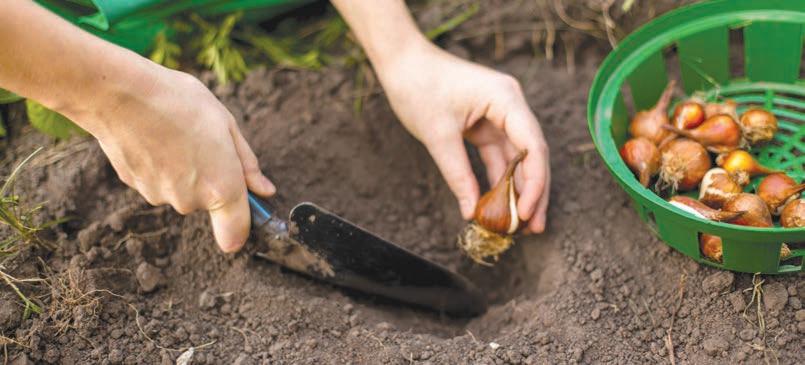
MIND YOUR SOIL
Most Bulbs Need Rich Soil, So Mix Some Compost Into Your Soil For the Best Results, Especially If Your Soil Is Heavy Clay or Has Poor Drainage. Loamy or Slightly Sandy Soil Is Ideal.
Prevent Weeds
The Best Way To Prevent Weeds Is To Add 2-3 Inches of Mulch On Top of Your Flowerbeds. Bulbs Can Easily Grow Up Through the Mulch. Weeds Will Have A Harder Time.
Weed Barrier Fabric Is Not Idea To Use When Planting Bulbs, Because It Can Prevent Moisture From Reaching the Roots of the Developing Bulb. If You Must Use Weed Barrier Fabric, Cut Slits In the Fabric At the Site of Each Bulb.
PLANT FOR VISUAL EFFECT
Consider When Your Flowers Will Bloom To Provide Blooms All Season Long. Different Plants
Bloom At Different Times During the Season. Others, Such As Such As Seedum, Daylilies, Hosta or Bleeding Heart, Will Bloom Repeatedly Until Late Fall or Provide Consistent, Rich Foliage. Mix Up Your Plantings So That Your Flowerbeds Provide Visual Interest All Season Long. Consult Longfield Gardens’ Bloom Time Chart For Spring and Summer Bulbs At Bit. ly/2KTQuQm To Help You Plan Your Flowerbeds.









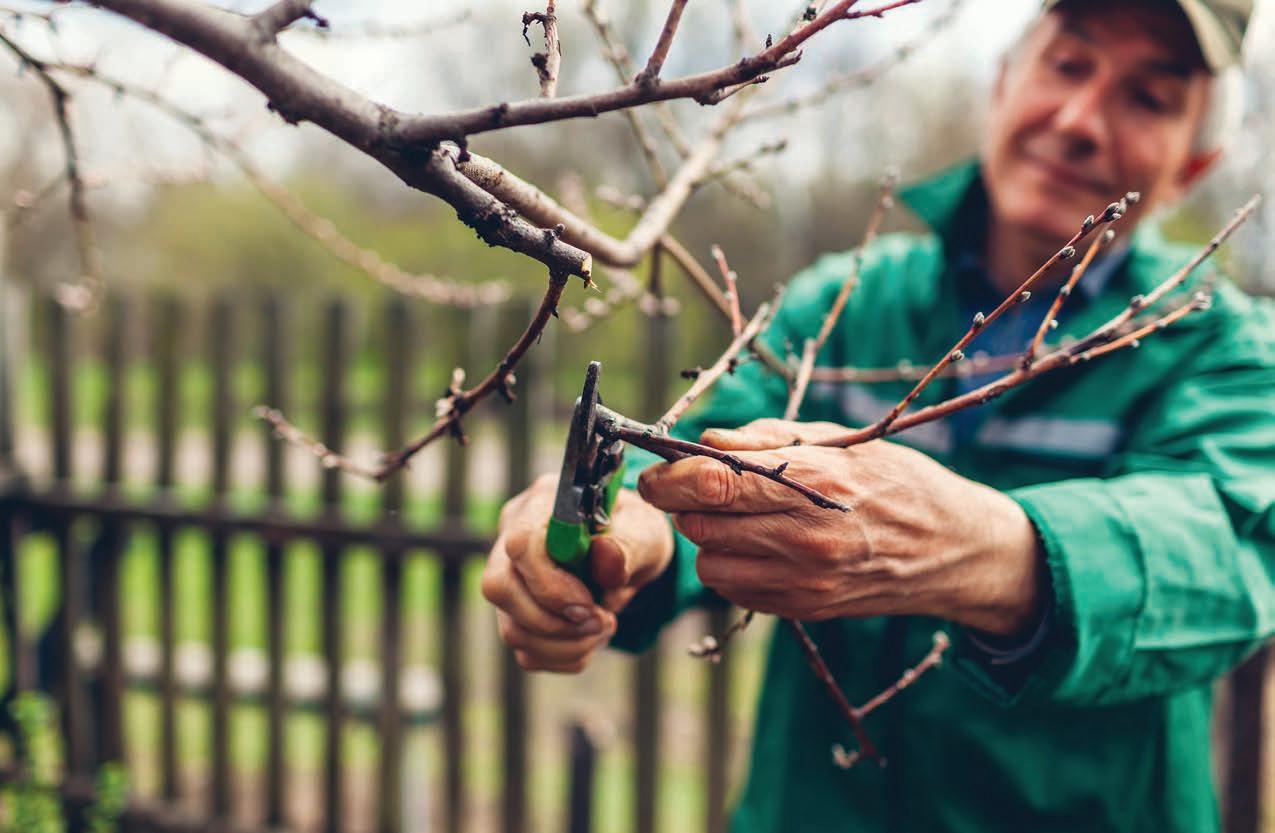
Many Perennials Have Foliage That Provides Protection During the Winter, But Pruning Is Still An Essential Part of their Growth Process. Likewise, Many Plants Actually Make Stronger Returns If Longer
Branches Are Trimmed. Here’s How To Handle This Essential Part of Spring Gardening.
WHEN SHOULD I PRUNE?
The Timing For Pruning
Shrubs and Trees Mostly Depends On When they Bloom and Whether Those Blooms Are On New or Old Growth, According To the Farmers Almanac. Generally, Plants Which Flower After Midsummer
Each Year Should Be Pruned After they Flower. A Common Worry Is That Over-pruning or Pruning At the Wrong Time Might Kill A Plant, But Garden Center Experts Say That It’s Rarely Fatal. Instead,
You’ll Simply Have Fewer Blooms or Less Fruit.
Fruit-bearing Trees Like Apple, Peach, Plum and Cherry Should Be Pruned In Early Spring, As Should Vines Like Wisteria and Trumpet Vine. Shrubs That Flower In the Spring Like Rhododendrons and Lilacs Also Need Pruning As Soon As their First Blooms Fade. This Helps Ensure A Better Bloom the Following Year. Blackeyed Susan, Purple Cone-
flower and Globe Thistle Seed-heads Provide A Terrific Food Source For Birds, So Growers Are Encouraged To Leave them Until Early Spring. Mums, Coral Bells, Hostas, Turtleheads and Delphiniums Need their Protective Foliage Through the Winter; Now Is the Time To Cut them Back.
Pruning Tools Like Shears and Clippers Must Be Kept Sharp In order To Do their Best Work. Clean Cuts Heal Quickly, Even-
tually Strengthening the Plant. Botched Cuts, On the Other Hand, Actually Weaken the Plant While Making It More Susceptible To Various Diseases.
Oil the Moving Parts
Before Spring Pruning To Make Sure Everything Works Smoothly.
Some Plants Require Less Aggressive Pruning. Talk To Representatives From Your Local Extension Service or Gardening Center To Learn More About How
Much To Prune A Particular Plant In Your Area. The Farmers Almanac Is Also A Helpful Guide. In General, Focus On Removing Dying or Dead Branches, and Sprouts That Have Emerged From the Trunk. With Trees and Shrubs, Remove All Branches That Are Growing Toward the Center, Downward or Across Other Branches. Prune From the Outside Growth Inward To Get the Most Pleasing Shape While Promoting Growth of Stronger New Branches.

A Number of Projects Has Exploded Since the Pandemic Began
All That Time At Home
During the Early Days of the Pandemic Led Many To Reassess their Living Spaces. But the Home Improvement Boom Has Continued, Even Years
Later. If You’re Still Waiting To Jump On the Bandwagon and Aren’t Sure Where To Begin, Contact A Service Pro To Discuss Whether One of these Trending Home Improve-
ment Projects Is Right For Your Property.
LARGER WINDOWS
If You’re Looking To Let More Light In, Don’t Simply Settle For More Win-
dows. Think Bigger — Much Bigger. Floor-toceiling Versions Are Transforming Spaces At An Increasing Rate. They Help Create A More Open, Luxurious Space, While

Appear To Be Both Larger and More Inviting. And Remember: They Don’t Have To Be Square. Talk To Your Contractor About Exciting Alternatives Like Ached Designs.
Bookcase-style Built-ins Have Long Been A Thing of the Past. But Emerging New Versions Promise Far More Functionality — and A Better Sense of Style. Recessed Spaces Can House Televisions, Multimedia Equipment, and Buffet Sets, and they’re
Being Constructed Now
With Contrasting Materials, Inlays and Crown Molding To Create A Bolder Impact.
Mudrooms Similarly Fell Out of Fashion, Despite their Obvious Every-day Uses. Better organizational Designs Have Led To A Resurgence, As Mudrooms Now Feature More Functional and Attractive Options For Storing Shoes, Umbrellas, Coats and More — Along With Sink Areas For Easy Cleanup. Talk To Your Contractor
Be Incorporated Into Your Entry.
Add Repurposed Materials Into Your Renovation Project, or Partner With Ecoconscious Companies To Create A New Look While Taking Care of Mother Earth. Talk To Your Contractor About A Focus On Wellness, Too. That May Include Spa Spaces, A Library For Quiet Reading, Redesigned Bathrooms, A Yoga Gym or Tranquil Rooms To Simply Escape It All.
Many of Us Finally Reconnected With Nature During the Quarantine Era When People Were Gathering Less. A Big Renovation Project Can Give You the Chance To Bring Similar Concepts Into Your Inside Space. You Might Change the Layout of Your Entryway To Make It Flow More organically, Choose More Natural Materials Like Wood, Stone or Linen, or Take Down Walls and Enlarge Windows So Sight Lines Take You All the Way Outside.




March brings spring and the urge to refresh our indoor and outdoor spaces.
From your own design inspiration to professionals who can offer expert advice, measurement, and installation, 2023 brings focus back to home.
It Can Be Quite Daunting To Get Started Tackling “Dream Home” Projects. Is It Time To Redo That Old Favorite Couch In the Living Room? Or, Finally Find Fun New Outdoor Pillows To Display For Spring? Maybe It’s Time To Finally Find the Right Sheer or Texture For Draperies In the Great Room.
If there’s One Thing Everyone Can Agree On In the Post COVID World, It’s That Being Comfortable In Your Own Home Should Never Be Taken For Granted. With Free In-store Design Services To Brighten Your Home and Bring Your Vision To Life, A One-stop-shop With Over 35 Years Experience Is Con-
tinuing To Inspire Delaware Residents With the Tools Needed To Reinvent their Homes. With An Endless Array of Design Elements, Walking Into the Interior Alternative Is Like Being A Kid In A Candy Store. You’ll Find Thousands of Indoor and Outdoor Fabric Selections Broken Into Categories Such As Ultra-high Performance, Classic Velvet, Bold Boucle, Caterpillar-like Chenille, Fauxsuede, Natural Cotton, Linen and More. All these Amazing Choices To Go Along With Designer-direct Prices. Prefer To Shop From Home?
The Staff Can Bring their Expertise Right To You. You
Can Redesign Your Entire Home Without Ever Leaving. A Design Professional Will Come Out To Your Home With Gorgeous, High-performance Fabric Swatches and Help You Select Just the Right Color and Pattern For Your Projects. We offer Customized Creations For Drapery/window Treatments, Sofas/sectionals, Bedding, Headboards, Cushions and Pillows For the Home. You Can Call Us Anytime (302-454-3232) and We Will Help Make Your Dream Home A Reality. We Do Home Appointments, In-store Appointments, and Walk-ins. Many of Our High Perfor-
mance, Best Selling Private Label Dorell Fabrics Are Available Both In the Store and On TheFabricOutlet. com. Our Dorell Private Label Develops An Abundance of New Products Each Year and Many of the Items At the Interior Alternative Cannot Be Found Anywhere Else In the Country. Whether You Are An Experienced Interior Designer or Looking To Redesign Your Home For the First Time, the Interior Alternative Is A Muststop-shop Before Tackling Any Home Decor Project. Our Staff Are Trained and Excited To Help You Redesign the Home of Your Dreams Without Breaking the Bank.


An Exciting Aspect of Spring Is the Return of Wildlife To Your Backyard. Flocks of Birds and Hungry Squirrels Will Likely Find A New Place To Call Home Throughout the Neighborhood.
Welcome their Friendly Chatter By Rewarding them With A Favorite Meal or Birdbath To Ensure they Continue To Make An Appearance.
If Your Goal Is To Create A Homestead That Invites Animals To Feel Safe and Find A Bite To Eat, Keep In Mind That Wildlife Is To Be Respected. Make Sure To Remind Children That Wild Animals Are Not Obedient Like their Favorite Pets and May Become Dangerous If they Feel Threatened. Watching and Learning About these Animals From A Distance Is A Wholesome Way To Spend Spring With Your Family.
Building A Safe and Attractive Haven For Animals To Flock May Not Happen Overnight, But By Following these Tips, Your Backyard Will Become An Entertaining Place For Beautiful Wildlife.
WATER SOURCES
One of the Most Popular Water Sources We Can offer Animals Is An Attractive Birdbath. Follow these Tips From Cornell University To Discover How To Place It For the Most Impact.
Birds Prefer Baths That Are Low To the Ground and Located Near Shady Areas.
Use Stones or Branches To Line Edges of the Water So Birds Have A Place To Stand While Drinking.
Water Should Be No Deeper Than One Inch At the Edges and Two Inches In the Middle. For A More Enticing Atmosphere, Include Dripping Water To Attract More Wildlife.
Don’t Forget To Regularly Clean the Birdbath As Its Occupants Will Likely Leave Behind Seeds, Droppings and Feathers.

When Considering Which Types of Feeders To Install, Think of the Wildlife You Are Trying To Attract. If A Colorful Variety of Birds Is Your Intention, Try To Use Several Boxes That offer them Different Ways To Eat. Some Animals Prefer To Dine While Perching, So A Hanging Feeder With Posts Will Be More Attractive. Other Less-picky
Eaters Will Be Fine With Eating From A Platform or Suet Style Option. Try To Incorporate Different Types of Seeds Throughout Your Yard To Learn What Your Local Species Are Most Interested In. Don’t Be Surprised To Find Animals Like Squirrels or Deer Visiting Your Yard To Finish Up the Food That Was Knocked To the Ground By Hungry Birds.




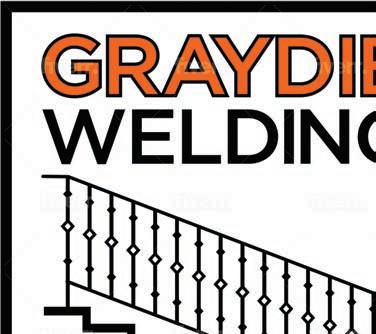





As We Welcome Spring’s Warmer Weather, Many Americans Prepare Forthe Uncomfortable and Life-limiting Months Associated With Seasonal Allergies. According Tothe Asthmaand Allergy Foundationof America, More Than 50 Million Citizens Suffer Each Year. and Enjoythe Comfortable Temperatures Without Irritation.
Spring Isoften To Blame As Pollen Is Released By Trees In Its Early Stages,then Grass Asthe Season Advances. Whilethere Is No Straightforward Cure For Seasonal Allergies, there Are Many Ways You Can Prepare Your Home To Limit Its Effect. Here Are Some Ways To Spring Clean Your Living Space
CLEAN UP THE CLUTTER
When You Begin Your Spring-cleaning Chores, You Can Lessenthe Dust Intrusion By Eliminating Clutter Aroundthe Home. Make Sure To Eradicate Areas With Things Like Old

Rags, Stacksof Magazines and Clothes You Don’t Wear.
Once Your Home Is Free and Clear, Give Your Carpet A Quality Cleaning. You Can Usually Rent A Commercial Shampooer From A Local Hardware Storeor Hire A Professional Cleaning Service To Make Your Floor Covering Pristine.
Many Typesof Carpet Can Hold Allergensand Distributethem Intothe Air Once they’re Disrupted. After A Deep Cleaning, Commit To Vacuuming At Least Once A Week To Maintain Its Clean Qualities.
BEDROOM CLEANING
Since We Spend So Much Time In Our Bedrooms, It’s



Important To Ensure the Area Is Clean and Free of Allergens. In Addition To Regular Dusting, Keep A Few Extra Sets of Bed Sheets and Pillowcases On Hand.
They Are Notorious For Holding Dust Mites or Pollen That We Bring Home On Our Clothes or Hair.
Try To Wash them In Hot Water At Least Once A Week and Rotate Different Coverings So You’re Not Left Without When Life Gets In the Way of Laundry.
Spring Invites Pollen and Other Allergens Into the Air
and Your Home. However, there Are Measures You Can Take To Keep Your Living Space Clean and Fresh. Check With An Expert To Inspect Your House’s Ventilation System and Ductwork. If there Are Compromised Components, Intrusion Like Moisture and Dust Are Commonly Introduced. You Should Also Invest In High-quality Air Filters In Your Heating and Cooling Appliances. When Your HVAC Expert Arrives For their Regular Maintenance, Ask them About More High-efficiency Options To Increase Your Home’s Defense.


Spring Means
Warming Conditions, and Less of A Need For Scarves, Gloves and Bulky Winter Items. Take Care To Store It All Properly, However, or they May Not Be In the Proper Condition To Keep You Cozy Again When the Seasons Change.
Properly Clean All Winter Wear Prior To Storing. Cleaned Items Keep Musty Odors Away, and Moths Too. Closely Follow
Manufacturer Instructions, Taking Note of Proper Washing Instructions — Including Requirements To Dry Clean Only. These Guidelines Will
nent After Being Put Away For Months. Dry-clean Items Shouldn’t Be Stored Inside the Plastic Carrying Bags From the Cleaners, Since they Can

Attract Moisture Which Promotes Mildew. Wrap Everything With Cotton Sheets Instead. This Material Keeps Dust Away While Also Promoting the Flow of Air.
Winter Wear Tends To Take Up A Lot of Room In Drawers and Closets. Storing these Bulky Items Allows Space For Lighter, More Spring-time Appropriate Items. Purchase Storage Containers That
Can Be Concealed In the Back of Closets or Under the Bed, Since You Won’t Need Easy Access To them For Many Warmer Months. These Bins, When Properly Closed, Prevent Intrusions By Unwanted Odors, Insects and Moisture. Cardboard Boxes Were Commonly Used To Store Clothing In the Past, But Should Be Avoided. They’re Constructed With Paper, Acid and Glues That Can Attract Pests Who Will then Potentially
Do Great Damage To Your Clothing and You Won’t Know Until the Temperatures Start Falling Again.
Climate Control Is Critically Important Whether You Plan To Keep Winter Clothes In Your Closet, Under the Bed or In Another Storage Area. Any Space Must Be Properly Ventilated, Cool and Dry – With Moisture Being the Most Important Ele-
ment To Guard Against. Avoid Keeping Things In An Unfinished Basement, Attic or Most Garages, Because they Don’t Include Important Safeguards. Weather Extremes and Potential Pest Infestations In Storage Areas That Are Not Climatecontrolled Can Lead Directly To Permanent Damage To Your Clothes. If It’s Increasingly Difficult To Find Room For Everything, Consider Donating Some Items To Charity.

If You’re Embarking On A Spring Cleaning Project, Getting the Kids Involved Can Teach Responsibility and Other Valuable Life Skills.
Every Parent Knows That Sometimes Teaching A Child To Do A Chore Is More Work Than Doing It Yourself, But Spending A Little Extra Time Now Can Help Set them Up To Be Great Household Helpers As they Grow. An Older Child Who Develops Useful Skills Such As Bike Repair or Lawn Maintenance Could Even Open their Own Summer Business.
Once Your Kids Have New Cleaning Skills Under their Belts, they’ll Be Able To Help More Around the House On An Ongoing Basis. (This Is A Great Time To Institute A Daily or Weekly Chore Chart, If You Haven’t Already.)
For Health and Safety, Have Kids Use All-natural Cleaning Supplies Whenever Possible, Such As Diluted Vinegar, Baking Soda, Lemon Juice and Toothpaste (for Polishing Metal Surfaces Such As Doorknobs and Fixtures.)
Set Each Child Up With A
Caddy of Cleaning Supplies they Will Need To Complete their Jobs. Here Is A List of Chore Ideas For Small Hands To Get You Started.
• Washing Windows and Windowsills.
• Sorting Dirty Laundry and Removing Clean Laundry From the Dryer.
• Dusting Baseboards and Furniture and Wiping Down Doorknobs and Light Switches.
• Wiping Down Kitchen Cabinets.
• Sorting Books and Magazines.
• Sweeping, Vacuuming and Mopping.
• Pulling Weeds and Watering Flowers and Houseplants.
• Sort Shoes and Put Away Winter Boots.
• Wipe Down Outdoor Toys.
• Put Away Winter Clothing and Put Out Springtime Wardrobe.

• Using A Broom To Remove Cobwebs From Porches and Overhangs.
• Washing and Vacuuming the Car.
• Cleaning Bathrooms.
• Cleaning and Vacuuming Under Couch Cushions.
• Clean Out and Wipe Down Refrigerator Shelves and Drawers.
• Deep Cleaning Microwave and Stove.
• Changing Bed Sheets and Laundering Linens.
• Mowing the Lawn and Helping With Yard Work, Such As Weeding, Planting Bulbs or Putting Down Mulch.
• Sweeping the Patio or Deck and Wiping Down Outdoor Furniture.
• Cleaning Out Pet Kennels and Laundering Pet Beds.
• Perform Maintenance and Make Simple Repairs To Sports Equipment and Bicycles, Such As Airing Up A Basketball or Replacing Bicycle Brakes.






Carefully Read Over Everything Before Signing A Contract
So You’ve Found the Right Home Service Pro, After Looking Over their Credentials and A Detailed Estimate. Next You’ll Enter Into A Formal Agreement That
Will Outline What Work Is To Be Done, Materials To Be Used, How Much It Will Cost and When It Should Be Finished, Barring Outside Issues.
If Something Is Incorrect or Left Out, Your Signature Could Mean You End Up With An Incomplete Project That Doesn’t Suit Your Taste or Meet Your Needs.
Several Key Elements Are Part of A Professionally Executed Contract That Protects Both You and the Home Service Pro. The
Document Should Include A Job Description That Details What’s To Be Done, With A Detailed Outlineof Costsandthe Materials To Be Used. There Should Be Dates To Startand Completethe Work, As Partof An Agreed-upon Project Timeline. Payments Should Be Tied To Job-completion Milestones. The Contract Should Make Clear That Securingthe Necessary Permits Isthe Responsibilityofthe Company.
Penalties Should Be In Place For Missing Detailed
Completion Dates. There Should Be A Stated Procedure For Changing Work orders. Insurance, Bonding and Licensing Details Must Be Included. Protections Should Also Be Built Into the Contract, Including A Termination Clause Describing Howthe Deal Can Be Voided By Either the Homeownersorthe Contractor As Well As A Lien Release That’s In Place Inthe Eventthere Is A Dispute With Any Subcontractororthe Company’s Workers.
There Aren’t Universal Rules About Some Issues, Including Down Payment. In Some Places, A Written Contract Isn’t Even Required. But It’s Smart To Request One Anyway. This Ensures That Expectations Are Defined and Sets A Schedule For When Benchmarks Including Workand Pay Are Expected To Happen. Research State Laws Before Signing To Make Surethe Agreement Meets Local Standards.
If Regulations Set A Baseline Figure For Down Payments, Try To Agree To A Figure As Close To That As Possible. The Lowerthe Upfront Cash Outlaw,the More Incentive Contractors Have To Expeditethe Work Onthe Way To A Quicker Finish. Check In Regularly As Work Progresses,and Set Up Regular Meetings To Catch Up On How Things Are Goingand To Discuss Any Issues That Have Popped Up Alongthe Way. The More You’re Involved,the Fewer Times You’ll Be Surprised.

















The Garage Is A Great Place To Store Household Items When they’re Not In Use. Basic — But Sturdy — Shelving Units Can Do the Job.
If You’re Short On Space In Your Garage, However, Consider Some Creative Storage Options To Maximize Your Storage Space.
Using the Vertical Space In Your Garage Helps Free Up Floor Space. Anything You Don’t Access On A Regular Basis Can Be Hoisted Up. Look For Bicycle Storage Systems That Use Rope and A Pulley With Hooks Attached At the End To Allow You To Safely Store Your Bikes Overhead. A Similar Pulley System Can Be Used To Elevate A Metal Shelf Where You Can Store Items In Plastic Bins Overhead. If You Have Access To A Ladder, A Fixed Overhead Storage Shelf Is Also An Option.
If You’re Short On Floor Space, Look For Creative Options For Storing Items Such As Bikes, and Sports and Lawn Equipment On the Wall. A Modular Wallmounted Slat Storage System Allows You To Customize Your Storage For

Your Particular Items. Add Hooks, Wire Baskets or Shelves To the Slats To Store Items of A Variety of Shapes and Sizes — From A Rake To A Garden Hose To A Bicycle. Even the Inside of Your Garage Door Can Be Made Into Useful Storage Space. Attach Metal Brackets To Hold Light Sports Equip-
ment Such As Fishing Rods Horizontally.
FUNCTION OVER FORM
Of Course You Could Go All-out With A Brand New Customized Garage Storage System, But You Don’t Have To Spend A Lot To Make Your Space Functional. If You’re On A Budget, Consider Hitting the
Classified Ads, Yard Sales or A Resale Shop For Garage Storage Options. If You Don’t Mind Less Than Perfect Aesthetics, Look For Quality Items That Might Have Some Cosmetic Defects. The Key Is To Focus On Being Sure the Storage Units You Choose Are Sturdy Enough To Hold Your Items.





New To Town and Don’t Know Any Handymen? Worried About Purchasing
An Older Home or Concerned About Extending Manufacturer Warranties?
A Home Warranty Can Provide Some Comfort and Confidence.
Home Insurance Covers
Property Damage As A Result of Fire, Wind, theft, Hail or Vandalism, As Well As Liability For Guests Who Visit the Policyholder’s Property. A Home Warranty, By Contrast, Helps Mitigate the Risk of Huge Outof-pocket Expenses For Things Inside Your House. They Can Also Extend An Expiring Manufacturers Warranty. You Can Sign Up For A Home Warranty At Any Time, Though they Are Most often Attached To A Real-estate Transaction, Typically As A Sales Incentive or To Boost Buyer Confidence.
These Warranties Cover Repair, Service or Replacement of Major Appliances and Home Systems, Creating A Buffer In the Unfortunate Instance Where A Big-ticket Item Fails. You
Won’t Have To Find Individual Repairmen On Your Own. Instead, You’ll Be Connected With Local Affiliated Workers Who Will Handle Service Calls To Evaluate Covered Items. A Contractor Is Dispatched By the Home-warranty Company, and they Will Diagnose the Issue then Repair or Recommend Replacement of the Item.
WHEN TO BUY
Older Systems or Appliances That Are No Longer Under Manufacturers Warranties Are Prime Candidates For Home Warranty Coverage, Since Replacing A Refrigerator, Air Conditioners, Water Heater or Furnace Can Be So Expensive. Sellers May Want To Add A Home Warranty To Cover the Cost of Things Breaking Down Before the Sale Closes, or As A Selling-point Incentive. Buyers Can Purchase the Home

With Confidence That A Big Bill Isn’t Looming If Something Fails. Those Who Have Limited Mobility, On A Fixed Income or In their Senior Years May Also Want the Peace of Mind.
REVIEW ANNUALLY
If You Choose To Purchase A Home Warranty, Keep In Mind That Most Are Sold On A Yearly Basis. Some Companies offer Two- or Three-year Plans, But It’s
Still Smart of Review the Coverage Annually. What Worked In 2023 Might Not In 2024. A Manufacturers Warranty May Be Ending, or You May Have Purchased A New Appliance. Or Perhaps You Haven’t Had the Need For This Coverage, and Feel Better Situated To Contact Local Repairmen On A Case-by-case Basis. Make Sure the Plan Meets Your Current Needs.





Your HVAC May Need A Good Looking Over Before Things Heat Up

If Winter Has Left You Frosty and Frigid, You May Have A Steamy Future Ahead As Temperatures Rise. Now Is the Time To Hire A Local Service Pro To Take A Look At Your Heating, Ventilation and Air-conditioning System — Otherwise
Known As HVAC. While Searching, However, You’re Likely To Find Pages and Pages of Service and Repair Company Results. Determining Which One Is Best Prepared To Ready Your System Can Seem Like A Daunting Task. Thankfully,
there Are A Number of Key Indicators Which Will Help When Searching For A Home Service Pro To Look Over Your HVAC.
DO YOUR RESEARCH
Work Done Before A Contractor Rings the Doorbell Will Ensure You
Get the Best Quality Service At A Reasonable Price. Search For Home Service Pros Who Are Properly Certified. Reputable HVAC Companies Hire Employees Who Have North American Technician Excellence Certification. NATE Is the
Nation’s Not-for-profit Certifying organization For HVAC and Refrigeration Techs. Technicians Have To Earn Re-certification Every Two Years, Meaning they Remain Upto-date On Industry Developments and New Standards. Make Sure Any Contractor Is Also Properly Insured, With Both Business and Liability Policies. This Protects You and the Service Pro In Case there’s A Mishap With the Equipment or In Your Home.
ASK AROUND
Once You’ve Confirmed That the Paperwork Is In Place, Look Into their References. Check Trusted Websites Including Yelp, NextDoor and Google For Online Testimonials or Complaints, and Ask the Contracting Company Directly To Speak With Other Customers. Be Particularly Wary If An HVAC Company Refuses To Provide these References, Since That Could Be A Sign That they Have Burned



Some Bridges. Check In With the Better Business Bureau, and Ask Friends, Family and Neighbors For their Recommendations, Too. Once You’ve Gathered This Wealth of Guidance and Advice, You’ll Be Able To Make A Hiring Decision With the Peace of Mind That Comes From Doing Your Homework.
REQUEST DETAILED ESTIMATES
Once You’ve Narrowed Down the Possibilities,
Ask For Detailed Estimates From Several Contractors. They Should Spend A Good Amount of Time Looking Over Your System In order To Evaluate Your Needs. Replacement Systems Will Be Tailored To the Size of Your Home, Insulation Details, Number of Floors and Windows. Repairs Will Involve Duct System and Unit Inspections. Get Itemized Written Estimates For Comparison, While Noting Warranty Options.
Some Home Projects Simply Aren’t Worth the Risk, Not To Mention the Time and Money. Adding On To Your Home Is A Complicated, Multilevel Project That Typically Involves A Range of Skills Too Broad For the Average Weekend Fixer-upper. There Could Also Be official Paperwork and Insurance Considerations. If You Run Into One or More of these Problems, You Might Never Finish.
Taking Out A Section of Drywall Is One Thing. Properly Mediating Potentially Dangerous Substances Like Asbestos, Mold or Lead Is Quite Another. They’re Very Harmful To You and Your Family’s Health, So Must Be Handled With the Proper Protective Measures.
The Ease of Connecting A New Light Fixture or Switching Out An Outlet Might Convince You That Larger Electrical Jobs Are

Within Reach. But Major Jobs, Like Connecting Power To A That New Addition, Must Be Done By A Licensed Professional. The Work Is Dangerous, and Bad Wiring Jobs Run the Risk of Fire Down the Road.
Serious Structural Issues Require Expertise and Heavier Machinery To Correct. Don’t Leave the Safety of Your Home and Loved Ones To Chance With A Foundation That Is Need of Repair Because of Cracks or Crumbling Structure.
If You’re Dealing With Anything Other Than A Small Tree, Consider Calling Someone With the Skills and Expertise To Properly Trim and Remove It. They’ll Have the Equipment To Reach Higher Branches, While Safely Bringing Larger Trees Down. Climbing A Tree With A Chainsaw Could Be A Lethal Mistake.
As With Electrical Work, there Are DIY Jobs (switching Out A Toilet, Replacing Kitchen-sink Fixtures) and then there
Are Jobs Which Require More Knowledge and Expertise (water-main Issues, Plumbing A New Room). Improperly Replaced or Installed Water Sources Can Lead To Serious Damage or Whole-house Flooding.
The DIY Approach Is Fine For Minor Annoyances, Like A Single Instance of Roaches, Ants or A Mouse. Larger Infestations of Pests Like Bees, Termites, Bats or Squirrels Require A Pro To Root Out the Problem and Properly Address It.








